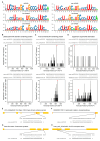MicroRNA528 and Its Regulatory Roles in Monocotyledonous Plants
- PMID: 40806465
- PMCID: PMC12347108
- DOI: 10.3390/ijms26157334
MicroRNA528 and Its Regulatory Roles in Monocotyledonous Plants
Abstract
MicroRNA528 (miR528) is a microRNA found only in monocotyledonous (monocot) plants. It has been widely reported that miR528 is involved in the regulation of plant growth and development, such as flowering, architecture, and seed and embryogenic development, in addition to playing a crucial role in response to various biotic and abiotic stresses, such as plant pathogens, salt stress, heat/cold stress, water stress, arsenic stress, oxidative stress, heavy-metal stress, and nutrient stress. Given that it is specific to monocot plants, to which the major staple food crops such as rice and wheat belong, a review of studies investigating its diverse functional roles and underlying mechanisms is presented. This review focuses on the processes in which miR528 and its targets are involved and examines their regulatory relationships with significant participation in plant development and stress responses. It is anticipated that more biological functions and evolutionary effects of miRNA targets will be elucidated with the increase in knowledge of miRNA evolution and examination of target mRNAs.
Keywords: MicroRNAs; miR528; plant development; post-transcriptional gene regulation; stress.
Conflict of interest statement
The authors declare no conflicts of interest.
Figures


Similar articles
-
Management of urinary stones by experts in stone disease (ESD 2025).Arch Ital Urol Androl. 2025 Jun 30;97(2):14085. doi: 10.4081/aiua.2025.14085. Epub 2025 Jun 30. Arch Ital Urol Androl. 2025. PMID: 40583613 Review.
-
Short-Term Memory Impairment.2024 Jun 8. In: StatPearls [Internet]. Treasure Island (FL): StatPearls Publishing; 2025 Jan–. 2024 Jun 8. In: StatPearls [Internet]. Treasure Island (FL): StatPearls Publishing; 2025 Jan–. PMID: 31424720 Free Books & Documents.
-
The Black Book of Psychotropic Dosing and Monitoring.Psychopharmacol Bull. 2024 Jul 8;54(3):8-59. Psychopharmacol Bull. 2024. PMID: 38993656 Free PMC article. Review.
-
T-bet expressing Tr1 cells driven by dietary signals dominate the small intestinal immune landscape.bioRxiv [Preprint]. 2025 Jul 4:2025.06.30.662190. doi: 10.1101/2025.06.30.662190. bioRxiv. 2025. PMID: 40747421 Free PMC article. Preprint.
-
Phase separation as a key mechanism in plant development, environmental adaptation, and abiotic stress response.J Biol Chem. 2025 Jun;301(6):108548. doi: 10.1016/j.jbc.2025.108548. Epub 2025 Apr 24. J Biol Chem. 2025. PMID: 40286852 Free PMC article. Review.
References
Publication types
Grants and funding
LinkOut - more resources
Full Text Sources

